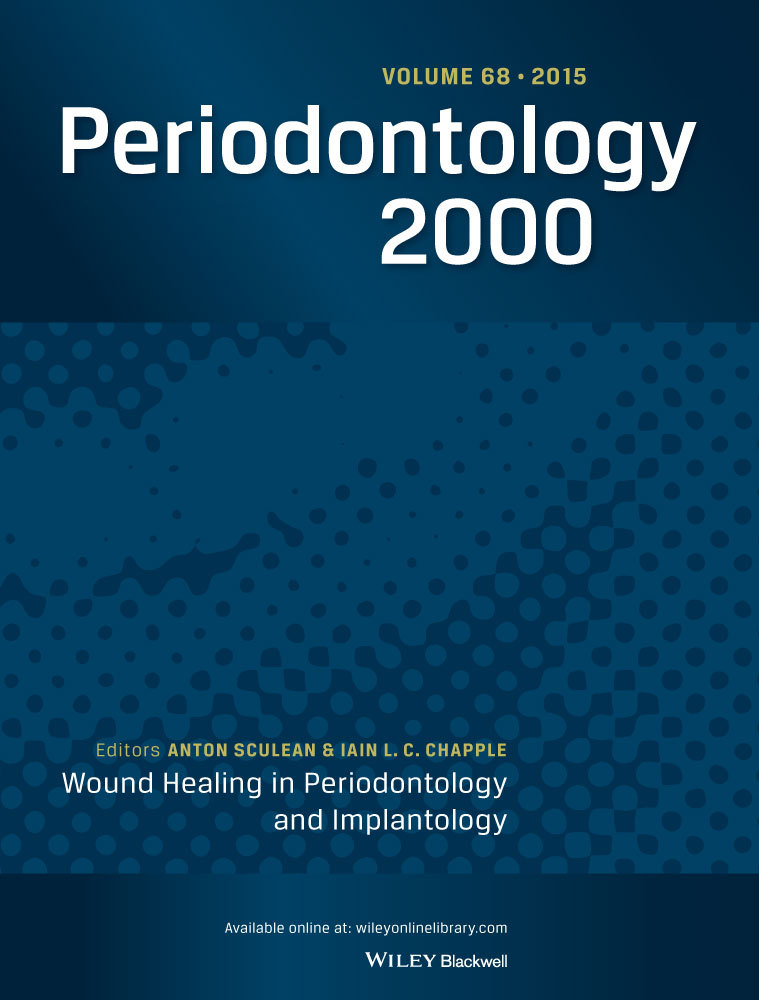Diagnostic methods/parameters to monitor peri‐implant conditions
IF 15.7
1区 医学
Q1 DENTISTRY, ORAL SURGERY & MEDICINE
引用次数: 0
Abstract
The diagnostic accuracy of clinical parameters, including visual inspection and probing to monitor peri‐implant conditions, has been regarded with skepticism. Scientific evidence pointed out that primary diagnostic tools (chairside) seem to be highly specific, while their sensitivity is lower compared with their use in monitoring periodontal stability. Nonetheless, given the association between pocket depth at teeth and implant sites and the aerobic/anaerobic nature of the microbiome, it seems plausible for pocket probing depth to be indicative of disease progression or tissue stability. In addition, understanding the inflammatory nature of peri‐implant diseases, it seems reasonable to advocate that bleeding, erythema, ulceration, and suppuration might be reliable indicators of pathology. Nevertheless, single spots of bleeding on probing may not reflect peri‐implant disease, since implants are prone to exhibit bleeding related to probing force. On the other side, bleeding in smokers lacks sensitivity owing to the decreased angiogenic activity. Hence, the use of dichotomous scales on bleeding in the general population, in contrast to indices that feature profuseness and time after probing, might lead to false positive diagnoses. The definitive distinction between peri‐implant mucositis and peri‐implantitis, though, relies upon the radiographic evidence of progressive bone loss that can be assessed by means of two‐ and three‐dimensional methods. Accordingly, the objective of this review is to evaluate the existing clinical and radiographic parameters/methods to monitor peri‐implant conditions.监测种植体周围状况的诊断方法/参数
临床参数(包括用于监测种植体周围状况的视觉检查和探诊)的诊断准确性一直受到怀疑。科学证据指出,初级诊断工具(椅旁)似乎具有很高的特异性,但与用于监测牙周稳定性的工具相比,其敏感性较低。尽管如此,考虑到牙齿和种植部位的牙周袋深度与微生物群的需氧/厌氧性质之间的联系,牙周袋探查深度似乎可以指示疾病的进展或组织的稳定性。此外,由于种植体周围疾病具有炎症性,因此主张出血、红斑、溃疡和化脓可能是病理学的可靠指标似乎也是合理的。然而,探诊时的单个出血点可能并不能反映种植体周围疾病,因为种植体很容易出现与探诊力有关的出血。另一方面,由于血管生成活性降低,吸烟者的出血缺乏敏感性。因此,与探诊后出血量和出血时间的指数相比,使用二分法对普通人群的出血情况进行评分可能会导致假阳性诊断。不过,要明确区分种植体周围粘膜炎和种植体周围炎,需要依靠放射影像学证据来证明骨质的逐渐流失,而骨质流失可以通过二维和三维方法进行评估。因此,本综述旨在评估现有的临床和放射学参数/方法,以监测种植体周围的情况。
本文章由计算机程序翻译,如有差异,请以英文原文为准。
求助全文
约1分钟内获得全文
求助全文
来源期刊

Periodontology 2000
医学-牙科与口腔外科
CiteScore
34.10
自引率
2.20%
发文量
62
审稿时长
>12 weeks
期刊介绍:
Periodontology 2000 is a series of monographs designed for periodontists and general practitioners interested in periodontics. The editorial board selects significant topics and distinguished scientists and clinicians for each monograph. Serving as a valuable supplement to existing periodontal journals, three monographs are published annually, contributing specialized insights to the field.
 求助内容:
求助内容: 应助结果提醒方式:
应助结果提醒方式:


